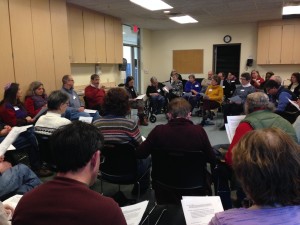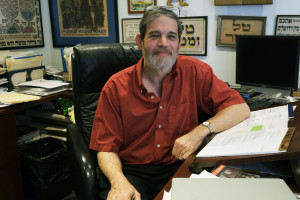
Yesterday, AARC and the Jewish Alliance for Food, Land, and Justice hosted 50 people for two lovely events, led by our visiting Rabbi, Michael Strassfeld. Tu B’Shevat–the “birthday of the trees”–provided us a great occasion to focus for the weekend on Judaism and the environment.
Another post will talk about the Tu B’Shevat seder. In this one, I want to share with people who couldn’t make it to the afternoon text study some of the passages and insights offered by Rabbi Michael.
We started with two verses from Deuteronomy (20:19-20):
When you besiege a city for a long time, making war against it in order to take it, you shall not destroy its trees by wielding an axe against them. You may eat from them, but you shall not cut them down. Are the trees in the field human, that they should be besieged by you? Only the trees which you know are not fruit trees may you destroy and cut down, that you may construct siegeworks against the city that is making war with you until it falls.
It’s an interesting passage, with several ideas in it. For starters, the text suggests that even in war, ethical constraints remain–and not just the most urgent ethical constraints, dealing directly with human lives. Fruit trees take many years to grow, and of course they are important sources of food. So this rule against their destruction may be founded on the obligations the current generation has to the future.
It’s a limited point, though; the explicit permission to use other, non-fruit-bearing, trees as battering rams and so on makes that clear. This is not a modern environmentalism; it’s expressing something narrower. Still, we learned, Maimonides extended the concept somewhat:
It is forbidden to cut down fruit-bearing trees outside a (besieged) city, nor may a water channel be deflected from them so that they wither. . . . [This applies] not only to cutting it down during a siege, but whenever a fruit-yielding tree is cut down with destructive intent. . . . It may be cut down, however, if it causes damage to other trees or to a field belonging to another man or if its value for other purposes is greater (than that of the fruit it produces). The Law forbids only wanton destruction. . . . Not only one who cuts down (fruit-producing) trees, but also one who smashes household good, tears cloths, demolishes a building, stops up a spring, or destroys aricles of food with destructive intent, transgresses the command Thou shalt not destroy (bal tashit).
So according to Maimonides, the passage in Deuteronomy amounts to a comprehensive ethical ban on “wanton destruction,” whether in time of war or not, whether of a fruit tree or something else. This is broader, for sure–but still very limited. It reaches only wanton destruction: destruction that is for no appropriate purpose. And the focus remains on present-day human purposes. It seems to me the passage from Maimonides doesn’t quite capture the cross-generational insight from the original Torah passage. But that’s what we moved to next. [Read more…] about Harvesting Jewish learning to nurture an environmental ethic







